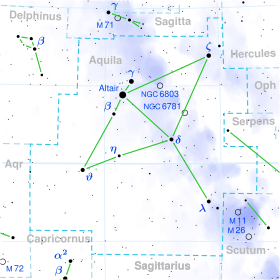12 Aquilae
| Observation data Epoch J2000 Equinox J2000 | |
|---|---|
| Constellation | Aquila |
| Right ascension | 19h 01m 40.82887s [1] |
| Declination | –05° 44′ 20.7222″ [1] |
| Apparent magnitude (V) | 4.02[2] |
| Characteristics | |
| Spectral type | K1 III[3] |
| U−B color index | +1.04[2] |
| B−V color index | +1.104[4] |
| R−I color index | 0.54 |
| Astrometry | |
| Radial velocity (Rv) | –43.92 ± 0.18[4] km/s |
| Proper motion (μ) | RA: −22.592 mas/yr[1] Dec.: −43.08 mas/yr[1] |
| Parallax (π) | 21.5669 ± 0.2199 mas[1] |
| Distance | 151 ± 2 ly (46.4 ± 0.5 pc) |
| Absolute magnitude (MV) | 0.726[5] |
| Details | |
| Mass | 1.185±0.282[6] M☉ |
| Radius | 12.28±0.14[6] R☉ |
| Luminosity | 58.2±3.1[7] L☉ |
| Surface gravity (log g) | 2.31±0.11[6] cgs |
| Temperature | 4,662±59[7] K |
| Metallicity [Fe/H] | −0.08±0.07[6] dex |
| Rotational velocity (v sin i) | 3.6[4] km/s |
| Age | 3.64±1.43[7] Gyr |
| Other designations | |
| Database references | |
| SIMBAD | data |
12 Aquilae (abbreviated 12 Aql) is a star in the equatorial constellation of Aquila. 12 Aquilae has the Bayer designation of i Aquilae and is most easily recognized in the sky being next to the brighter star λ (lambda) Aquilae.
In Chinese, 天弁 (Tiān Biàn), meaning Market Officer, refers to an asterism consisting of 12 Aquilae, α Scuti, δ Scuti, ε Scuti, β Scuti, η Scuti, λ Aquilae, 15 Aquilae and 14 Aquilae.[9] Consequently, 12 Aquilae itself is known as 天弁六 (Tiān Biàn liù, English: the Sixth Star of Market Officer.)
This star has an apparent visual magnitude of 4.02,[2] which is bright enough to be seen with the naked eye, although, according to the Bortle Dark-Sky Scale, it is a challenge to view from the inner city. Based upon an annual parallax shift of 21.57 mas,[1] the distance to this star is 151 light-years (46 parsecs) with a margin of error of one light-year. This is an evolved giant star of stellar class K1 III.[3] It has 12 times the radius of the Sun[6] and shines with 58 times the Sun's luminosity. This energy is being radiated from its outer atmosphere at an effective temperature of 4,662 K,[6] giving it the cool orange hue of a K-type star.[10]
References
[edit]- ^ a b c d e Vallenari, A.; et al. (Gaia collaboration) (2023). "Gaia Data Release 3. Summary of the content and survey properties". Astronomy and Astrophysics. 674: A1. arXiv:2208.00211. Bibcode:2023A&A...674A...1G. doi:10.1051/0004-6361/202243940. S2CID 244398875. Gaia DR3 record for this source at VizieR.
- ^ a b c Johnson, H. L.; et al. (1966), "UBVRIJKL photometry of the bright stars", Communications of the Lunar and Planetary Laboratory, 4 (99): 99, Bibcode:1966CoLPL...4...99J.
- ^ a b Roman, Nancy G. (July 1952), "The Spectra of the Bright Stars of Types F5-K5", Astrophysical Journal, 116: 122, Bibcode:1952ApJ...116..122R, doi:10.1086/145598.
- ^ a b c Massarotti, Alessandro; et al. (January 2008), "Rotational and Radial Velocities for a Sample of 761 HIPPARCOS Giants and the Role of Binarity", The Astronomical Journal, 135 (1): 209–231, Bibcode:2008AJ....135..209M, doi:10.1088/0004-6256/135/1/209, S2CID 121883397.
- ^ Soubiran, C.; et al. (2008), "Vertical distribution of Galactic disk stars. IV. AMR and AVR from clump giants", Astronomy and Astrophysics, 480 (1): 91–101, arXiv:0712.1370, Bibcode:2008A&A...480...91S, doi:10.1051/0004-6361:20078788, S2CID 16602121.
- ^ a b c d e f Soubiran, C.; Creevey, O. L.; Lagarde, N.; Brouillet, N.; Jofré, P.; Casamiquela, L.; Heiter, U.; Aguilera-Gómez, C.; Vitali, S.; Worley, C.; de Brito Silva, D. (2024-02-01), "Gaia FGK benchmark stars: Fundamental Teff and log g of the third version", Astronomy and Astrophysics, 682: A145, Bibcode:2024A&A...682A.145S, doi:10.1051/0004-6361/202347136, ISSN 0004-6361 12 Aquilae's database entry at VizieR.
- ^ a b c Baines, Ellyn K.; Armstrong, J. Thomas; Schmitt, Henrique R.; Zavala, R. T.; Benson, James A.; Hutter, Donald J.; Tycner, Christopher; Van Belle, Gerard T. (2018), "Fundamental Parameters of 87 Stars from the Navy Precision Optical Interferometer", The Astronomical Journal, 155 (1): 30, arXiv:1712.08109, Bibcode:2018AJ....155...30B, doi:10.3847/1538-3881/aa9d8b, S2CID 119427037.
- ^ "i Aql", SIMBAD, Centre de données astronomiques de Strasbourg, retrieved 2012-07-22.
- ^ (in Chinese) 中國星座神話, written by 陳久金. Published by 台灣書房出版有限公司, 2005, ISBN 978-986-7332-25-7.
- ^ "The Colour of Stars", Australia Telescope, Outreach and Education, Commonwealth Scientific and Industrial Research Organisation, December 21, 2004, archived from the original on February 22, 2012, retrieved 2012-01-16.

